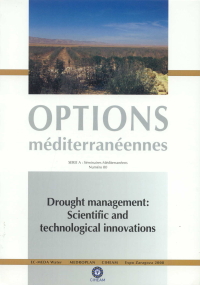| Article précédent | p. 83-86 | Article suivant |
Drought and climate change in Morocco. Analysis of precipitation field and water supply
The studies made by the Moroccan Meteorological Office (La Direction de la météorologie nationale) have shown obvious changes in the climate the country has undergone in recent decades including the phenomenon of drought. The thirty year period 1971-2000 registered a decline of about 15% in the annual average of water supply. Since 1961, 1982-83, 1983-84 and 1994-95 were the hydrological years of most severe droughts that Morocco has experienced. The year 1994-95 has seen the minimum volume of precipitation water supply ranging from 38% in the north-west and south-west, to 80% in the south-east. The following year 1995-1996 has recorded the maximum value of such water supply since 1961, following the strong precipitation in the beginning of the rainy season. In addition, the inter-annual precipitation field experienced a trend of yearly decline, with a slight increase at the beginning of the season, and a decline afterward, especially in the spring. Drought is a plague that exists in Morocco since the beginning of the last century, with a cyclic temporal frequency of 11 years on average. Over the last three decades, the frequency, intensity and duration of drought have increased, and consequently, have led to an increase in their temporal persistence, especially in the spring.
Les études réalisées par la Direction de Météorologie Nationale ont mis en évidence les changements que le climat du pays a connus durant les dernières décennies, notamment le phénomène de la sécheresse. La période trentenaire 1971-2000 a enregistré une diminution des apports pluviométriques en eau annuelle moyenne de l'ordre de 15%. Depuis 1961, 1982-83, 1983-84 et 1994-95 étaient les années hydrologiques de sécheresses les plus sévères que le Maroc ait connues. La saison 1994-95 a enregistré le volume minimal des apports pluviométriques en eau variant de 38% au nord-ouest et au sud-ouest, à 80% au sud-est. L'année suivante 1995-96 a enregistré la valeur maximale de ces apports depuis 1961, suite aux très fortes précipitations du début de la saison. En outre, le régime pluviométrique inter-annuel connaît une tendance annuelle à la baisse, avec une légère augmentation des pluies de début de la saison et un déclin de celles du reste de la saison notamment au printemps. La sécheresse est un fléau qui existe au Maroc depuis le début du siècle dernier, sous forme cyclique d'une périodicité moyenne de 11 ans. Durant les trois dernières décennies, la fréquence, l'intensité et la durée de la sécheresse ont augmenté, entraînant en conséquence, une augmentation de leur persistance temporelle notamment au printemps.
- [ Afficher ]
- [ Télécharger ]
- [ Exporter la citation ]
Vous pouvez télécharger la citation au format :
- [ Imprimer ]
-
Mots-clés
APPROVISIONNEMENT EN EAU, DEFICIT PLUVIOMETRIQUE, MAROC, SECHERESSECiter cet article
Benassi M. Drought and climate change in Morocco. Analysis of precipitation field and water supply. In : López-Francos A. (ed.). Drought management: scientific and technological innovations. Zaragoza : CIHEAM, 2008. p. 83-86. (Options Méditerranéennes : Série A. Séminaires Méditerranéens; n. 80). 1. International Conference Drought Management: Scientific and Technological Innovations, 2008/06/12-14, Zaragoza (Spain). http://om.ciheam.org/om/pdf/a80/00800423.pdf



